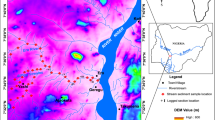Abstract
The granulometric analysis of loess varieties is meant to contribute to the subdivision of loess sequences, to the reconstruction of the environments of loess formation (identifying areas of loess origin [from where the dust derives], “geographical obstacles” to transport, contemporary wind directions [through drawing isokatharoses lines connecting points with identical FG values] and even wind velocities) and subsequent changes in climatic and geographical conditions. It was investigated whether loesses and loess-like deposits can be described by a generalised grain size parameter (fineness grade, FG) or to what extent other granulometric indices can lead to a more differentiated picture of grain size variation.
Fineness grade was used to denominate sediments and to identify finer and coarser sections in the series;K d index indicates the lithostratigraphical positions of cold stages (maximum values) and warm stages (minimum values); finesorting (S o) points to eolian accumulation, while fluvial deposits (bedload, saltated and suspended load) are poorly sorted;kurtosis (K) allows conclusions for the reworking of the deposit andasymmetry (Sk) indicates the factor active in the accumulation of the deposit.
The paper concentrates primarily on the study of variation in the vertical profile of deposits. Along with other indices, fineness grade was found useful in distinguishing between loess varieties and other sediments and could even replace the function of the conventional index median value (Md).
Similar content being viewed by others
References
An Zhisheng; Wei Lanying: The illuviation of ferriargillians and their genetic inference. Kexue Tongbao 24, 8, 356–359 (1978)
An Zhisheng; Wei Lanying: Magnetostratigraphy of the core S-5 and the transgression in the Beijing area during the early Matuyama Epoch. Geochimica 4, 343–346 (1979)
Bérczi, J.: Statistical evaluation of grain size distributions. In: Kriván, P. (ed.), Latest results in sediment petrology. pp. 59–123. Hungarian Geological Society, Budapest (1971)
Liu, T. (ed.): The Composition and Texture of Loess. China Ocean Press, Beijing 1985.
Molnár, B.: Sedimentological study of the Upper Pannonian and Pleistocene formations at Dunaújváros. Földtani Közlöny 101, 34–43 (1971) (in Hungarian with English summary)
Molnár, B.: Upper Pliocene (Levantan) and Pleistocene geological history of the Danube-Tisza Interfluve. Földtani Közlöny 107, 1–16 (1977) (in Hungarian with English summary)
Molnár, B.; Krolopp, E.: Latest Pleistocene Geohistory of the Bácska Loess Area. Acta Miner.-Petr. Szeged 6, 179–198 (1978)
Pécsi, M. (ed.): Lithology and stratigraphy of loess and paleosols. INQUA Commission on Loess and Paleopedology. 11th INQUA Congress, Geogr. Res. Inst. Hung. Acad. Sci. Moscow, 1984.
Pécsi, M.: Problems of loess chronology. GeoJournal 24, 2, 143–150 (1991)
Schönhals, E.: Kennzahlen für den Feinheitsgrad des Lösses. Eiszeitalter und Gegenwart 6, 133–147 (1955)
Siebertz, H.: Die Bedeutung des Feinheitsgrades als geomorphologische Auswertungsmethode. Eiszeitalter und Gegenwart 32, 81–91 (1982)
Author information
Authors and Affiliations
Rights and permissions
About this article
Cite this article
Kis, É. Granulometric investigations of loess profiles in Hungary. GeoJournal 36, 151–156 (1995). https://doi.org/10.1007/BF00813161
Issue Date:
DOI: https://doi.org/10.1007/BF00813161




